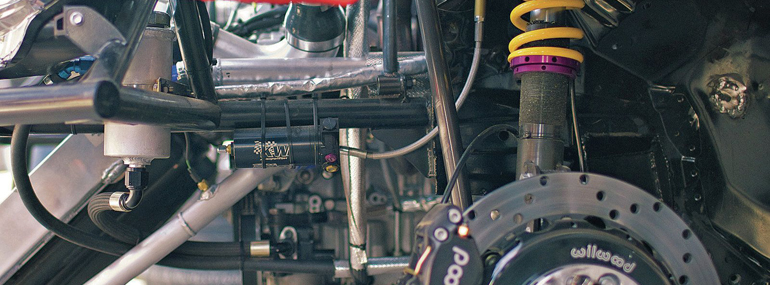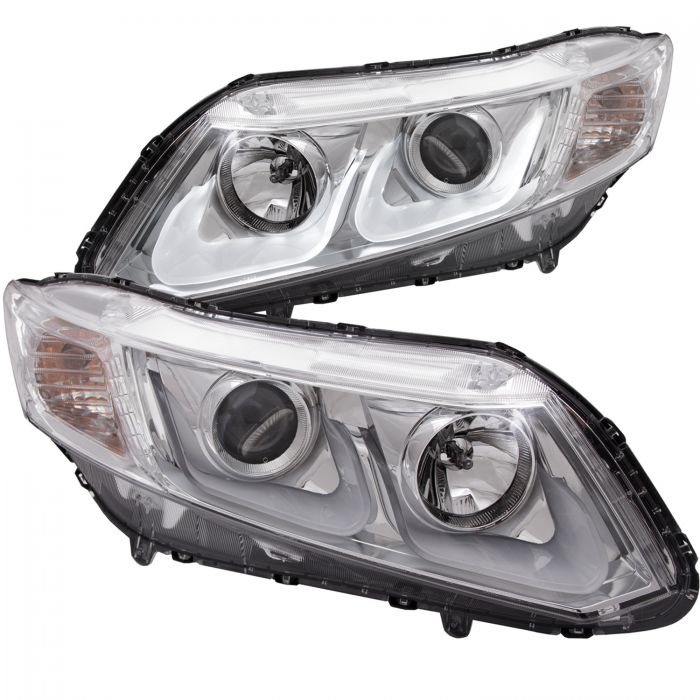Aftermarket Performance Suspension Alignment Buyers Guide

Camber Kits, Toe Kits, and Alignments
While it's often referred to simply as an alignment or wheel alignment, it's really complex suspension angles that are being measured and a variety of suspension components that are being adjusted. This makes an alignment an important suspension-tuning tool that greatly influences the operation of the vehicle's tires. Out-of-alignment conditions occur when the suspension and steering systems are not operating at their desired angles. Out-of-alignment conditions are most often caused by spring sag or suspension wear (ball joints, bushings, etc.) on an older. They can also be the result of an impact with a pothole or curb, or a change in vehicle ride height (lowered or raised) on any vehicle regardless of age. Incorrect alignment settings will usually result in more rapid tire wear. Therefore, alignment should be checked whenever new tires or suspension components are installed, and any time unusual tire wear patterns appear. Alignment should also be checked after the vehicle has encountered a major road hazard or curb.Front End, Thrust Angle, and Four Wheel Alignments Explained
The different types of alignments offered today are front-end, thrust angle, and four-wheel. During a front-end alignment, only the front axle's angles are measured and adjusted. Front-end alignments are fine for some vehicles featuring a solid rear axle, but confirming that the front tires are positioned directly in front of the rear tires is also important.
On a solid rear axle vehicle, this requires a thrust angle alignment that allows the technician to confirm that all four wheels are square with each other. Thrust angle alignments also identify vehicles that would dog track going down the road with the rear end offset from the front. If the thrust angle isn't zero on many solid rear axle vehicles, a trip to a frame straightening shop is required to return the rear axle to its original location.
On all vehicles with four-wheel independent suspensions, or front-wheel drive vehicles with adjustable rear suspensions, the appropriate alignment is a four-wheel alignment. This procedure squares the vehicle like a thrust angle alignment, and also includes measuring and adjusting the rear axle angles as well as the front.
Not all vehicles are easily adjustable or fully adjustable. Some vehicles require aftermarket kits to allow sufficient adjustment to compensate for accident damage or the change in alignment due to the installation of lowering springs.
When aligning a vehicle, it's appropriate for the vehicle to be carrying its typical load. This is important for drivers who continuously carry loads in their vehicles, such as sales representatives with samples or literature in the trunk. Additionally, when a vehicle is used for autocross or track events, some racers will sit in their car, or have the alignment shop ballast their vehicle to include the influence of the driver's weight on the suspension angles.
The primary static suspension angles that need to be measured and adjusted are caster, camber, toe and thrust angle. Here's a definition of each angle and its influence on a vehicle and its tires.
Camber
The camber angle identifies how far the tire slants away from vertical when viewed directly from the front or back of the vehicle. Camber is expressed in degrees, and is said to be negative when the top of the tire tilts inward toward the center of the vehicle and positive when the top leans away from the center of the vehicle.
Since street suspensions cannot completely compensate for the outer tire tipping towards the outside when the vehicle leans in a corner, there isn't a magical camber setting that will allow the tires to remain vertical when traveling straight down the road (for more even wear), and remain perpendicular to the road during hard cornering (for more generous grip).
Different driving styles can also influence the desired camber angle as well. An enthusiastic driver who corners faster than a reserved driver will receive more cornering grip and longer tire life from a tire aligned with more negative camber. However with the aggressive negative camber, a reserved driver's lower cornering speeds would cause the inside edges of the tires to wear faster than the outside edges.
What's the downside to negative camber? Negative camber leans both tires on the axle towards the center of the vehicle. Each tire develops an equal and offsetting camber thrust force (the same principle that causes a motorcycle to turn when it leans) even when the vehicle is driven straight ahead. If the vehicle encounters a bump that only causes one tire to lose some of its grip, the other tire's negative camber will push the vehicle in the direction of the tire that lost grip. The vehicle may feel more nervous and become more susceptible to tramlining. Excessive camber will also reduce the available straight-line grip required for rapid acceleration and hard stops.
Appropriate camber settings that take into account the vehicle and driver's aggressiveness will help balance treadwear with cornering performance. For street-driven vehicles, this means that tire wear and handling requirements must be balanced according to the driver's needs. The goal is to use enough negative camber to provide good cornering performance while not requiring the tire to put too much of its load on the inner edge while traveling in a straight line. Less negative camber (until the tire is perpendicular to the road at zero camber) typically will reduce the cornering ability, but results in more even wear.
Even though they have some of the most refined suspensions in the world, the next time you see a head-on photo of a Formula 1 car or CART Champ Car set up for a road course, notice how much negative camber is dialed into the front wheels. While this is certainly an example of wear not being as important as grip, negative camber even helps these sophisticated racing cars corner better.
Toe
The toe angle identifies the exact direction the tires are pointed compared to the centerline of the vehicle when viewed from directly above. Toe is expressed in either degrees or fractions-of-an-inch, and an axle is said to have positive toe-in when imaginary lines running through the centerlines of the tires intersect in front of the vehicle and have negative toe-out when they diverge. The toe setting is typically used to help compensate for the suspension bushings compliance to enhance tire wear. Toe can also be used to adjust vehicle handling.
A rear-wheel drive vehicle pushes the front axle's tires as they roll along the road. Tire rolling resistance causes a little drag resulting in rearward movement of the suspension arms against their bushings. Because of this, most rear-wheel drive vehicles use some positive toe-in to compensate for the movement, enabling the tires to run parallel to each other at speed.
Conversely, a front-wheel drive vehicle pulls the vehicle through the front axle, resulting in forward movement of the suspension arms against their bushings. Therefore most front-wheel drive vehicles use some negative toe-out to compensate for the movement, again enabling the tires to run parallel to each other at speed.
Toe can also be used to alter a vehicle's handling traits. Increased toe-in will typically result in reduced oversteer, help steady the car and enhance high-speed stability. Increased toe-out will typically result in reduced understeer, helping free up the car, especially during initial turn-in while entering a corner.
Before adjusting toe outside the vehicle manufacturer's recommended settings to manipulate handling, be aware that toe settings will influence wet weather handling and tire wear as well.
Excessive toe settings often bring with them drivability problems, especially during heavy rain. This is because the daily pounding of tractor trailers on many highways leave ruts that fill with water. Since excessive toe means that each tire is pointed in a direction other than straight ahead, when the vehicle encounters a puddle that causes only one tire to lose some of its grip, the other tire's toe setting will push (excessive toe-in) or pull (excessive toe-out) the vehicle to the side. This may make the vehicle feel unsettled and very nervous.
Additionally the vehicle's toe is one of the most critical alignment settings relative to tire wear. A toe setting that is just a little off its appropriate setting can make a huge difference in their wear. Consider that if the toe setting is just 1/16-inch off of its appropriate setting, each tire on that axle will scrub almost seven feet sideways every mile! Extend it out and you'll discover that rather than running parallel to each other, the front tires will scrub over 1/4-mile sideways during every 100 miles of driving! Incorrect toe will rob you of tire life.
Conclusion
An accurate wheel alignment is critical to balance the tread wear and performance of the vehicle. Almost anytime you make changes with the suspension, you'll change up the alignment one way or another. As you can see, Camber and Toe kits are essential to any tuner wishing to lower their vehicle to improve their handling as well as prolong tire life.
2012-2015 Honda Civic Si Headlights
-
2012-2015 Honda Civic Si Headlights
Want to change the look of your 9th Generation Civic Si without spending a whole lot of money? The headlights that we carry can make a huge difference in appearance and in most cases are one of the most popular modifications we offer. We have many different choices, one of those being just simply upgrading to Projector headlights. Some of our headlights do come with the latest in modern modifications being led daytime running lights. One other benefit as well, being a projector headlight is visibility, projecting a steady beam of concentrated light to project further than most standard headlights.
Best Selling Camber Kits








